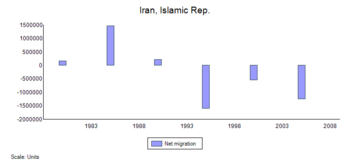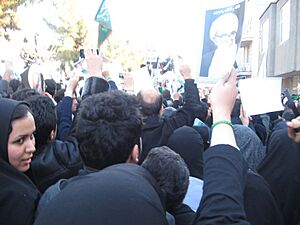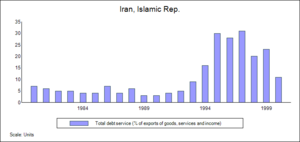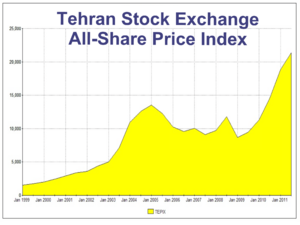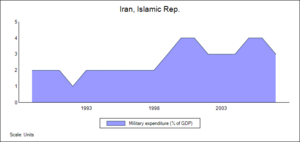History of the Islamic Republic of Iran facts for kids
In 1979, Iran experienced a huge change in its government, known as the Iranian Revolution. The country's leader, Shah Mohammad Reza Pahlavi, was overthrown. In his place, Ayatollah Ruhollah Khomeini became the new leader.
Before the revolution, Iran was a monarchy, ruled by a king. After 1979, it became an Islamic republic. This new government was based on Islamic laws and led by religious scholars called Shiite jurists. These jurists, especially the Supreme Leader of Iran, held many powerful roles.
Iran's foreign policy also changed. Before, Iran was friendly with Western countries like the United States. After the revolution, it adopted a policy of "neither east nor west." This meant Iran would not side with major world powers. The new government also made the veil (hijab) mandatory for women and strongly opposed the United States and Israel.
Ayatollah Ruhollah Khomeini, who led the revolution, was Iran's Supreme Leader until he passed away in 1989. After him, Ali Khamenei became the Supreme Leader.
Since 1999, Iran has seen several large protests. These include student protests in 1999, protests after the 2009 presidential election, and more in 2011–2012, 2019–2020, and the 2022-2023 Mahsa Amini protests. The government has often stopped these protests with force, and many people have been killed.
Contents
- Iran's Big Changes Since 1979
- Khomeini's Time as Leader (1979-1989)
- Rafsanjani's Time as President (1989-1997)
- Khatami's Time as President (1997-2005)
- Ahmadinejad's Time as President (2005–2013)
- Rouhani's Time as President (2013-2021)
- Raisi's Time as President (2021-Present)
- Images for kids
- See also
Iran's Big Changes Since 1979
Iran has grown a lot since the revolution. Its population increased from 39 million in 1980 to over 81 million by 2017.
Some things stayed the same. Iran is still a major power in its region. It is much larger than its neighbors in the Persian Gulf. It also has huge amounts of gas and oil. Iran's long history and strong government, along with its oil money, have helped it achieve good levels of income, education, and healthcare. Modern trends like more people living in cities and going to college have also continued.
How Iran is Governed
The Islamic Republic of Iran is a religious government called a theocracy. It is led by a Supreme Leader. The country's constitution was approved in 1979 and updated in 1989. The official religion is a specific branch of Shiite Islam.
Religious bodies oversee the government. There is an elected president and elected groups at national and local levels. All citizens aged 18 and older can vote. However, the Council of Guardians must approve all candidates who want to run for parliament (the Islamic Consultative Assembly). This council also decides if new laws can be passed.
Iran's Relationships with Other Countries
After the 1979 revolution, Iran's government completely changed its foreign policy. It stopped being pro-Western. Since then, Iran has sometimes focused on spreading its revolutionary ideas. At other times, it has tried to improve its economy and have normal relations with other countries. After 2005, Iran became more strict. It often disagreed with Western countries and its neighbors.
Soon after the revolution, Iran fought a war with Iraq. Iraq's leader, Saddam Hussein, invaded Iran in 1980. Most foreign aid went to Iraq, so Iran had to agree to a ceasefire by 1988. Even after the war, tensions with Iraq remained high. Relations only began to improve after Saddam Hussein's death.
Iran also created and supported a group in Lebanon called Hezbollah. This group's leaders followed Ayatollah Khomeini. Hezbollah was formed and funded by Iran because Israel occupied parts of Lebanon. Since then, Hezbollah has been an ally for Iran in its conflicts with America and Israel.
The Islamic Republic strongly supports the Palestinian cause. The government provides aid to Palestinian hospitals and even arms. There is a special "Quds (Jerusalem) Day" and many streets in Iranian cities are named after Palestine.
Improving People's Lives
Even with economic challenges, Iran's Human Development Index (which measures things like life expectancy, education, and living standards) got much better after the revolution. It went from 0.569 in 1980 to 0.759 in 2007/8. This is similar to how much Turkey improved. One big reason for this improvement was that more Iranian women learned to read and write. Their literacy rate went from 28% to 80% between 1976 and 1996.
The Islamic Republic based its education changes on Islamic ideas. The Literacy Movement Organization (LMO) helped reduce illiteracy from 52.5% in 1976 to just 24% by 2002. This organization set up over 2,000 learning centers and taught literacy to a million people. This meant that for the first time, most people in Iran could speak and read in Persian.
In healthcare, the number of mothers and babies dying during childbirth was greatly reduced. Infant deaths per 1000 births dropped from 104 to 25.
Life in the countryside also improved a lot. A program called Reconstruction Jihad built roads, brought electricity and water, and set up health clinics in villages. This helped farmers and gave them access to things like radios, refrigerators, and televisions. Before the revolution, people lived to about 56 years old. By the end of the century, it was closer to 70.
Iran's Economy
After the Islamic Revolution, Iran's economy relied heavily on oil and gas exports. These made up 70% of the government's income and 80% of its export earnings by 2008. The government directly controlled about 60% of the economy. A unique part of Iran's economy is the large religious foundations, called Bonyads. Their budgets are said to be as much as half of the central government's budget.
Iran faced economic problems. The oil industry was damaged by the revolution and the Iran–Iraq War. Iran lost an estimated $500 billion. The population also grew very quickly. Other issues included government inefficiency, too much reliance on oil, and corruption.
The International Monetary Fund reported that Iran's income per person more than doubled since the revolution. It went from $4,295 in 1980 to $11,396 by 2010.
However, many Iranians often complain about the economy. One expert, Jahangir Amuzegar, noted in 2003 that even though oil income doubled, most signs of economic well-being got worse. Inflation was twice as high, unemployment three times higher, and economic growth was much slower. As a result, Iran's income per person dropped by at least 30% since 1979. More than 15% of the population lived in poverty.
When oil prices dropped, income per person also fell. The middle class had to sell off their savings, like carpets and gold, to make ends meet. Poor people also showed their unhappiness. Poverty increased by nearly 45% in the first six years after the revolution. Sometimes, poor people protested against their homes being destroyed or rising food prices.
A study from 2002, which was leaked, showed that nearly 90% of Iranians were unhappy with the government. Many wanted big or gradual changes.
People Leaving Iran
Many people, especially young students, try to leave Iran. They say there are not enough good jobs. It is estimated that two to four million skilled people, like engineers and business owners, left Iran after the revolution. This "brain drain" of smart people is thought to have cost Iran $80–120 billion.
Many Iranians feel sad about their families being split apart because so many people have left the country.
Society and Culture
The revolution brought some Islamic changes to Iran, especially in how people dressed. Men grew beards, and women wore the hijab. However, it did not reverse all modern trends. For example, traditional family life, like having many children or men having multiple wives, did not become more common.
Even though the legal age for girls to marry was lowered to nine, and Ayatollah Khomeini supported early marriage, the average age for women to marry actually rose to 22 by 1996. The age difference between husbands and wives also became smaller.
Islamic family laws did not lead to more polygamous families (where a man has more than one wife) or more divorces. Polygamy stayed at about 2% of marriages, and the divorce rate slightly decreased.
The government encouraged population growth for the first nine years after the revolution. But in 1988, concerns about youth unemployment led to a big change. Iran now has one of the world's most effective family planning programs.
After the revolution, Iranian women continued to hold important positions in politics. In the late 1990s, Iran had more women in its parliament than the U.S. had in its Senate.
Western culture, sometimes called Gharbzadegi ("westoxification"), still remains popular in Iran. People listen to illegal music, watch videos, and use satellite dishes, even though the government tries to stop it. Wearing the compulsory hijab for women is strictly enforced by police. Men are not allowed to wear shorts, necklaces, "glamorous" hairstyles, or neckties in government buildings. Western music is banned but is still very popular. A survey found that 61% of students in Tehran chose Western artists as their role models.
Human Rights
In the first five years of the Islamic Republic, about 8,000 political opponents were executed. Thousands more political prisoners were executed in 1988.
As of 2022, Iran had the second-highest number of executions after China, with 582 people executed. By September 2023, 499 people had been executed that year.
Religion in Iran
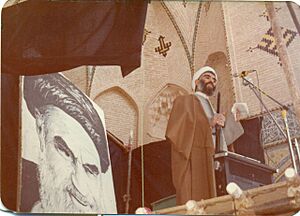
Iran is governed by Sharia law, which is Islamic law. It is one of the few Muslim countries where women are required by law to wear the hijab. However, Iran also has the lowest mosque attendance of any Islamic country. Religious leaders have said that over 70% of the population does not perform daily prayers, and less than 2% attend Friday prayers.
Life for religious minorities in Iran has been mixed. Khomeini called for unity between Sunni and Shi'a Muslims. He also issued a religious order (fatwa) saying that Jews and other minorities (except Baháʼís) should be treated well. Non-Muslim religious minorities do not have equal rights. For example, top government jobs are only for Muslims. However, four out of 270 seats in parliament are saved for Jewish, Christian, and Zoroastrian minorities.
The 300,000 members of the Baháʼí Faith face harassment. About 200 have been executed, and others have been forced to change their religion or face severe difficulties. The new government started targeting Baháʼí leaders in late 1979.
Scientific Progress
Iran's scientific progress faces challenges like funding issues and international sanctions. However, in some areas like medicine, surgery, pharmacology, stem cell research, and theoretical physics, Iranian scientists have gained international recognition since the revolution. Nuclear technology and stem cell research have received special support from the government.
In 2005, Iran's science budget was less than $1 billion. But since 1990, Iran's scientific output has grown very quickly. Iran now has the fastest growth rate in science and technology worldwide.
Iran is a leader in stem cell technology. It was the 10th country to produce human embryonic stem cells.
Khomeini's Time as Leader (1979-1989)
Ayatollah Khomeini was the main leader of Iran for ten years, from April 1979 until his death in mid-1989. During this time, the Islamic Republic was established as a religious government under Khomeini. Iran also fought a long and costly war with Iraq.
The Islamic Revolution Begins
The Islamic Republic of Iran started with the Iranian Revolution. Large protests against Shah Mohammad Reza Pahlavi began in January 1978. The Shah fled Iran in January 1979 after strikes and protests stopped the country. On February 1, 1979, Ayatollah Khomeini returned to Tehran, greeted by millions of Iranians. The Shah's rule ended on February 11 when Iran's military declared itself neutral. Iran officially became the Islamic Republic on April 1, 1979, after most Iranians voted for it.
Global Impact of the Revolution
The Islamic Revolution had a huge impact around the world. In non-Muslim countries, it changed how people viewed Islam. It created interest in Islamic politics and spirituality, but also fear and distrust towards the Islamic Republic. In the Middle East and Muslim world, especially early on, it created great excitement. It also increased opposition to Western involvement.
Strengthening the Revolution
Iran remained unstable for a few years after the Islamic Republic was created. The economy and government were in chaos, and the military was disorganized. But by 1982 or 1983, Khomeini and his supporters had defeated rival groups and gained full control.
New Constitution
The first draft of Iran's new constitution had a president and parliament like many countries. Its only religious part was a Guardian Council to stop un-Islamic laws. But in the summer of 1979, an Assembly of Experts for Constitution, mostly made up of Khomeini's supporters, was elected. Their new draft gave the Guardian Council much more power. It also added a powerful role for a religious ruler, meant for Khomeini. This new constitution was approved by a public vote in December 1979.
Hostage Crisis
An event that helped pass the constitution and made the revolution more anti-American was the Iran hostage crisis. On November 4, 1979, Iranian students took over the U.S. embassy in Tehran. They held 52 embassy workers hostage for 444 days. The U.S. government cut off diplomatic ties and put economic penalties on Iran. They also tried an unsuccessful rescue mission. The hostages were finally released on January 20, 1981. This crisis also started American legal actions and penalties that separated Iran economically from the U.S.
Stopping Opposition
Different groups involved in the revolution disagreed about Iran's future. Those who thought the Shah would be replaced by a democratic government soon found Khomeini disagreed. In March 1979, he said, "do not use this term, 'democratic.' That is the Western style."
Over time, various opposition groups were banned or attacked. This included political parties, guerrilla groups, and even the leftist President Abolhassan Banisadr, who was removed from office in June 1981.
Iran–Iraq War (1980-1988)
The eight-year Iran–Iraq War was the most important international event for the Islamic Republic's first decade. It helped strengthen the revolution, but it cost Iran many lives and a lot of money.
After the revolution, leader Ruhollah Khomeini called for Islamic revolutions in other Muslim countries, including Iraq. Iraq was a large country next to Iran with a majority Shiite Muslim population.
The war began when Iraq's dictator, Saddam Hussein, invaded Iran in September 1980. He wanted to take advantage of Iran's military weakness after the revolution. Many top military leaders had been executed. Saddam also wanted to control more of the Persian Gulf and the oil in Khuzestan Province. Iranians believe Saddam was encouraged by the United States and Saudi Arabia.
Strong resistance from Iranians and mistakes by Iraqi forces soon stopped the invasion. By early 1982, Iran had regained almost all the land it lost. The invasion united Iranians behind the new government and strengthened Khomeini's leadership. After this, Khomeini refused Iraq's offer for a truce. He said, "the regime in Baghdad must fall."
The war continued for six more years. Other countries, especially the Soviet Union, helped Iraq. Iraq also used chemical weapons against Iranian soldiers. As the war became more costly and Iranians grew tired, Khomeini finally accepted a truce in 1988. By then, Iran was almost bankrupt and had lost many soldiers. An estimated 200,000 Iranians were killed. The war cost Iran an estimated $627 billion.
Early Laws of the Islamic Republic
The new government changed the Shah's old Family Protection Law. It lowered the marriage age for girls back to nine. It also allowed husbands to divorce their wives easily without court permission. Women were removed from judicial jobs, and secular teachers from schools. Baháʼís were removed from government jobs, their centers were closed, and their leaders were arrested or executed. A strict "Islamic code of public appearance" was enforced. Men were discouraged from wearing ties, and women had to wear a scarf and long coat, or the full chador.
Economy in the Early Years
Iran's economy struggled in the first decade after the revolution. Its currency, the rial, fell sharply. The government took over many businesses, leading to a very large public sector. Many of these businesses lost money.
Human Rights in the Early Years
As of 2022, the government continued to severely limit freedoms of speech, assembly, and association. They banned independent political parties, unions, and other groups. They also censored media and blocked satellite TV channels.
In January, the government blocked Signal, adding it to a list of blocked social media platforms like Facebook, Telegram, Twitter, and YouTube.
During protests, the government often shut down the internet. This made it hard to know the full extent of actions by security forces.
Rafsanjani's Time as President (1989-1997)
The decade after the war is often called a time of practicality for Iran. The focus was on the economy first.
Akbar Hashemi Rafsanjani was elected president shortly after Khomeini's death. He was seen as less revolutionary than others. He was economically liberal, politically strict, and traditional in his beliefs. He served from 1989 to 1997. While Supreme Leader Khamenei generally supported his policies, some members of parliament initially disagreed.
These groups had strong differences over economic and foreign policy. Some supported state control of the economy and opposed normal relations with the West. Conservatives used their power to prevent candidates from running for office. For example, in 1992, nearly one-third of candidates for parliament were rejected. Many leading figures were removed because they lacked "proper Islamic credentials."
By 1994, hundreds of intellectuals and supposed critics were in prison, and some had been executed. These actions removed opponents from the government. However, they also set the stage for a reform movement.
Persian Gulf War (1990-1991)
Iraq invaded Kuwait on August 2, 1990. Many countries formed a group to respond. Iran criticized the invasion and supported penalties against Iraq. However, Iran did not actively join the war. This was not surprising given Iran's anti-Western views and its exhaustion from its recent war with Iraq. As a result of the war, over a million Kurds from Iraq crossed into Iran as refugees.
Economy Under Rafsanjani
Despite focusing on the economy, Iran faced serious economic problems during Rafsanjani's time. Economic growth between 1989 and 1994 was mostly paid for by borrowing about $30 billion from other countries. By 1993, Iran's foreign debt was 38% of its total economic output, which was worrying. A lack of foreign investment and a drop in oil prices led to an economic downturn. The Iranian rial currency fell sharply. Unemployment reached 30%. The prices of basic goods like sugar, rice, and bread increased a lot.
This economic decline was partly due to American economic penalties put in place in 1996. The U.S. stopped all trade with Iran, accusing it of supporting terrorist groups and trying to develop nuclear weapons.
Khatami's Time as President (1997-2005)
The eight years of Mohammad Khatami's presidency are sometimes called Iran's Reform Era. Khatami based his campaign on promises of a more democratic and open society. He wanted to promote civil society, the rule of law, and social rights. This included city council elections, respecting Iran's constitution, allowing criticism of high-ranking officials, and letting many different newspapers operate. He also wanted to reopen embassies with European countries and start a "Dialogue Among Civilizations."
Iran had a large young population, with about half the country born after the Islamic Revolution. Many of these young people supported Khatami.
Political and Cultural Changes
At first, this new era brought significant freedom. The number of daily newspapers in Iran increased from five to twenty-six. Magazine and book publishing also grew a lot. Iran's film industry boomed under Khatami, and Iranian films won awards at international festivals. Local elections, which had been delayed for over a decade, were finally held for towns and villages. The number of elected officials in Iran grew from 400 to almost 200,000.
Conservative Reaction
After taking office, Khatami faced strong opposition from powerful, unelected parts of the government. These included the Guardian Council, state media, police, armed forces, and the judiciary. This led to many conflicts between his government and these institutions.
In 1999, new limits were placed on the press. Courts banned more than 60 newspapers. Important allies of President Khatami were arrested and imprisoned. For example, the Tehran mayor, Gholamhossein Karbaschi, was tried on corruption charges. Interior Minister Abdollah Nouri was charged with "sacrilege."
In July 1999, conservatives closed a reformist newspaper. When students protested this closing, a Tehran University dormitory was attacked. Pro-democracy student protests broke out at Tehran University and other campuses. These were followed by protests from conservative groups.
Reformers won a big victory in the February 2000 parliamentary elections, getting about two-thirds of the seats. However, conservative parts of the government forced the closure of reformist newspapers. Supreme Leader Ali Khamenei stopped parliament's attempts to remove strict press laws. Despite these challenges, President Khatami was re-elected by a large margin in June 2001. Tensions between reformers in parliament and conservatives in the judiciary and the Guardian Council grew after Khatami's re-election.
Foreign Policy Under Khatami
Khatami worked to improve relations with other countries. He visited many nations and promoted a "dialogue between civilizations." He also encouraged foreign investment in Iran. He announced that Iran would accept a two-state solution for Palestine if Palestinians agreed to it. He eased restrictions on the Baháʼí community. He also assured Britain that Iran would not carry out the religious order against Salman Rushdie. Several European Union countries began renewing economic ties with Iran in the late 1990s.
The United States eased some of its economic penalties. However, it continued to block more normal relations. The U.S. argued that Iran was involved in international terrorism and was developing nuclear weapons. In his State of the Union Address, U.S. President George W. Bush called Iran, along with Iraq and North Korea, an "axis of evil."
Tensions with the United States increased after the Anglo-American invasion of Iraq in March 2003. U.S. officials increasingly criticized Iran for supposedly developing nuclear weapons.
The reform era ended when conservatives defeated Iranian reformists in the 2003, 2004, and 2005 elections. This happened partly because the reformist movement was divided and many reform candidates were banned from running.
Ahmadinejad's Time as President (2005–2013)
Mahmoud Ahmadinejad was elected president twice, in 2005 and 2009. Ahmadinejad ran as a conservative who promised to fight corruption, help the poor, and make Iran's national security stronger. In 2005, he won by a large margin against former president Rafsanjani. His victory was due to his popular economic promises and a very low voter turnout from reformist supporters. This win gave conservatives control of all parts of Iran's government.
His time in office was marked by controversy. He made strong statements against American "arrogance" and "imperialism." He also called Israel a "fabricated entity" that was "doomed to go." Opponents blamed his populist economic policies for high unemployment and inflation. These policies included cheap loans for small businesses and generous government help for petrol and food.
In 2009, Ahmadinejad's victory was highly disputed. It led to large protests that were the "greatest domestic challenge" to Iran's leadership in 30 years. Despite many people supporting his reformist opponent Mir-Hossein Mousavi, Ahmadinejad was officially declared the winner. Mousavi and his supporters immediately claimed voting problems. The protests continued on and off into 2011. Some 36–72 people were killed, and 4,000 were arrested. Supreme Leader Ali Khamenei called Ahmadinejad's victory a "divine assessment" and asked for unity. He and other officials blamed foreign powers for causing the protests.
By late 2010, there was a growing disagreement between Ahmadinejad and Khamenei. There was even talk of removing Ahmadinejad from office. The dispute was mainly about Esfandiar Rahim Mashaei, a top advisor to Ahmadinejad. Mashaei was accused of leading a "deviant current" that opposed more involvement of religious leaders in politics.
Foreign Relations Under Ahmadinejad
Even though the Supreme Leader handles things like appointing military commanders, Ahmadinejad gained a lot of international attention for his foreign policy. Under Ahmadinejad, Iran continued its strong ties with Syria and Hezbollah in Lebanon. It also built new relationships with its mostly Shiite neighbor Iraq and with Hugo Chavez of Venezuela, who also opposed U.S. foreign policy.
Ahmadinejad made strong statements in foreign affairs. He wrote personal letters to world leaders, including one to American president George W. Bush, inviting him to "monotheism and justice." He also declared there were no homosexuals in Iran. He expressed happiness at the 2008 global economic crisis, saying it would "put an end to liberal economy."
Hezbollah's reliance on Iran for military and financial aid is not supported by everyone in Iran. The 2006 Israel–Hezbollah War showed the world that Hezbollah had many weapons said to be from Iran.
Economy Under Ahmadinejad
Ahmadinejad's populist economic policies, like cheap loans for small businesses and generous government help for petrol and food, were boosted by rising oil export money until the Global financial crisis of 2008.
Gas Rationing in 2007
In 2007, President Mahmoud Ahmadinejad's government started the Gas Rationing Plan. This was to reduce the country's fuel use. Even though Iran produces a lot of petroleum, poor management, corruption, and limited refining capacity forced the country to import about 40% of its gasoline. This cost up to $7 billion each year.
Domestic Policy Under Ahmadinejad
Human Rights
According to the group Human Rights Watch, Iran's human rights situation "got much worse" under President Mahmoud Ahmadinejad. Starting in 2005, the number of executions increased from 86 in 2005 to 317 in 2007. Arbitrary arrests of "peaceful activists, journalists, students, and human rights defenders" also increased. They were often charged with "acting against national security."
Population and Cultural Issues
In April 2007, the Tehran police began a strict crackdown on "bad hijab" (improper Islamic dress). Thousands of Iranian women in Tehran were warned, and several hundred were arrested. By 2011, about 70,000 police in Tehran alone patrolled for clothing and hair violations. As of 2011, men were not allowed to wear necklaces, "glamorous" hairstyles, ponytails, or shorts. Neckties were forbidden in the holy city of Qom. After a leading religious figure issued a religious order against keeping dogs as pets, there was a crackdown on dog ownership.
Several controversial ideas by President Ahmadinejad and conservatives did not happen. These included plans to encourage larger families, to encourage polygamy, and to tax Mahriyeh (a payment a groom agrees to give his bride).
Rouhani's Time as President (2013-2021)
Hassan Rouhani was elected as President of Iran on June 12, 2013, and took office on August 3. He is known as a moderate politician and was supported by reformists in the election. He has open ideas about economics and foreign policy, having been a diplomat before his election. He quickly started talks with Western countries. He aimed to lift severe economic penalties on oil exports in exchange for Iran's cooperation on UN treaties about nuclear weapons. Economic conditions improved during Rouhani's first term, leading to his re-election in 2017.
The 2017–18 Iranian protests spread across the country against the government and its Supreme Leader. These protests were a response to the economic and political situation. Many people participated, and thousands of protesters were arrested. The 2019–20 Iranian protests started on November 15 in Ahvaz. They spread quickly after the government announced fuel price increases of up to 300%. A week-long total Internet shutdown across the country was one of the most severe internet blackouts ever. In the bloodiest government crackdown on protesters in the Islamic Republic's history, tens of thousands were arrested and hundreds were killed within days.
On January 3, 2020, the revolutionary guard's general, Qasem Soleimani, was killed by the United States in Iraq. This greatly increased tensions between the two countries. Three days later, Iran's Islamic Revolutionary Guard Corps launched a retaliatory attack on U.S. forces in Iraq. They also shot down Ukraine International Airlines Flight 752, killing 176 civilians. This led to nation-wide protests. An international investigation led to the government admitting that the plane was shot down by a missile due to "human error," after three days of denial.
Raisi's Time as President (2021-Present)
Ebrahim Raisi was elected as President of Iran on June 18, 2021, and took office on August 8. He is known as a right-wing politician. He wants economic freedom for Iran and sees sanctions against Iran as a chance for economic growth. He was quoted saying, "Sanctions should be seen as an opportunity for economic empowerment, and we should strengthen ourselves instead of falling short."
Mahsa Amini Protests
Perhaps the biggest event during Raisi's presidency as of 2023 was the arrest and tragic death of Mahsa Amini on September 16, 2022. This led to widespread protests. Amini, a 22-year-old Iranian woman, was arrested for allegedly wearing her hijab improperly. She died in custody three days later.
The protests sparked by her death were "unlike any the country had seen before." They were the "biggest challenge" to the government, with tens of thousands arrested and over 500 killed. By September 2023, the protests had been stopped. Authorities were working to crack down on women not wearing headscarves and to bring back the compulsory hijab.
Raisi's public response to the protests caused by Mahsa Amini's death was to promise to set up a commission to investigate her death. However, this did not stop the protests.
Images for kids
See also
- Foreign relations of Iran
- International rankings of Iran
- Islamic fundamentalism in Iran
- Nuclear program of Iran
- COVID-19 pandemic in Iran


